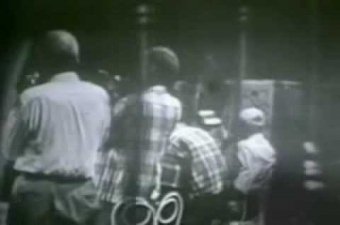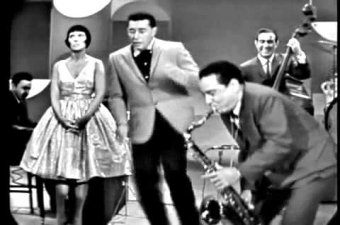The Dream Room
426 Bourbon StreetNew Orleans LA 70130
When Sam Anselmo and his partners opened the Dream Room in 1956, they billed it as “Bourbon Street’s only Dance Lounge,” a classy place where “Ladies are invited without escort.” The dance floor was spacious and the bandstand saw national touring acts from doo wop stars the Ink Spots to big band drummer Gene Krupa. Traditional jazz groups played here, too, including those led by Paul Barbarin, Tony Almerico, and Sharkey Bonano. Trombone great Jack Teagarden played his last show at the Dream Room.
As white audiences caught on to R&B, more hometown talent cycled through, including a teenaged Skip Easterling, called the “Blue Eyed Soul Brother.” The club became known for its jam sessions that wailed from 4am until 9am on Sunday mornings. Guitar ace Edgar Blanchard and his band (“Those Fabulous, Zany, Torrid and Entertaining Gondoliers”), already well established in Black clubs, became regulars.
Another group known for its late night residency here was Danny White and the Cavaliers. In 1962 White cut “Kiss Tomorrow Goodbye” for Frisco Records, which became a New Orleans classic but ran into distribution issues nationally. In any event, White’s band was one of the hottest live R&B acts in town. Guitarist Irving Bannister recalled the scene in Jeff Hannusch’s The Soul of New Orleans:
Every night the place was packed…We usually had a job before we played the Dream Room, and a lot of people would follow us there. Sam Butera used to come in the Dream Room and steal Danny [White’s] stage routine. I know, because I saw him in Las Vegas and he had Danny’s stuff down pat. Mac Rebennack [aka Dr. John] used to come in there a lot and watch me play.
Thievery aside, Bourbon Street gigs were valuable opportunities for young musicians to learn from veterans. In addition to Rebennack, the guitarist Ernie Vincent looked to Bannister—who’d played with Sugar Boy Crawford and Guitar Slim—to teach him his first chords (Vincent would go on to cut “Dap Walk,” a funk burner with an inimitable guitar sound).
The Dream Room closed in late 1964. Your Father’s Mustache, a national nightclub chain with a Gay 90s theme, moved in with a novelty “Dixieland” band called the G-String Strugglers. The bar sold beer steins with the slogan “Where the time of your life is right under your nose.” In 1975, an employee set it on fire.
About Bourbon Street
Bourbon Street, one of the most famous streets in the country, is only 14 blocks long, running through the middle of the French Quarter. It took off as an entertainment district in the 1940s, when wartime activity brought waves of visitors to New Orleans. Bands often performed in floor shows featuring burlesque dancers (who stripped to varying degrees), comedians, and other entertainers.
This freewheeling era came to a close, in the eyes of many patrons, with District Attorney Jim Garrison’s vice raids in the early 1960s. Crime — organized and not — was pervasive on Bourbon Street, and Garrison’s crusade scored some political points. The resulting loss of revenue at the clubs, meanwhile, scaled back entertainment budgets.
The only black people on Bourbon Street at the time were there to work (musicians were generally considered hired help; some had to wait in storerooms between sets). Even after the passage of civil rights legislation some clubs resisted integration, and audiences on Bourbon Street remained largely white for years afterward.
In recent decades, as the city relied increasingly on tourism to prop up its economy, the market dictated more changes: Modern stripping supplanted burlesque and DJ booths replaced bandstands. The street became a pedestrian mall, filled with go-cups and Mardi Gras beads year-round. Several clubs sticking with live music offered low wages for bands to play songs familiar to visitors.
Hand-wringing about the quality and nature of live music on the strip has been more or less constant since the 1950s, and not without reason. Still, some venues persisted in hiring reputable artists. In the 2000s, the To Be Continued Brass Band took matters into their own hands, breaking into the scene by playing on the corner of Bourbon and Canal Street every night.
In any case millions of visitors to the strip each year find the spectacle they’re looking for, exotic but approachable, with a more permissive atmosphere than they feel at home. Its economic impact on the city is in the billions. If it’s crass it’s also egalitarian: Bourbon Street today is among the more integrated spaces in town.
Videos

Traditional jazz and brass band drummer Paul Barbarin, who played across the country with the likes of King Oliver, performing "My Bucket's Got a Hole In It."
Video posted by bestdrumvideos.
Traditional jazz and brass band drummer Paul Barbarin, who played across the country with the likes of King Oliver, performing "My Bucket's Got a Hole In It."

Sam Butera, with Louis Prima and Keely Smith, performs his slow-burning version of "Night Train." He started playing behind strip tease acts on Bourbon Street at 14, and reportedly took elements of his act from Danny White.
Video posted by mrdantefontana666.
Sam Butera, with Louis Prima and Keely Smith, performs his slow-burning version of "Night Train." He started playing behind strip tease acts on Bourbon Street at 14, and reportedly took elements of his act from Danny White.

From the 2017 Ponderosa Stomp Music History Conference, Meters bassist George Porter, Jr. and drummer "Wacko" Wade Wright discuss gigging on Bourbon Street in the 1960s.
Video posted by The Ponderosa Stomp Foundation.
From the 2017 Ponderosa Stomp Music History Conference, Meters bassist George Porter, Jr. and drummer "Wacko" Wade Wright discuss gigging on Bourbon Street in the 1960s.
Images



























